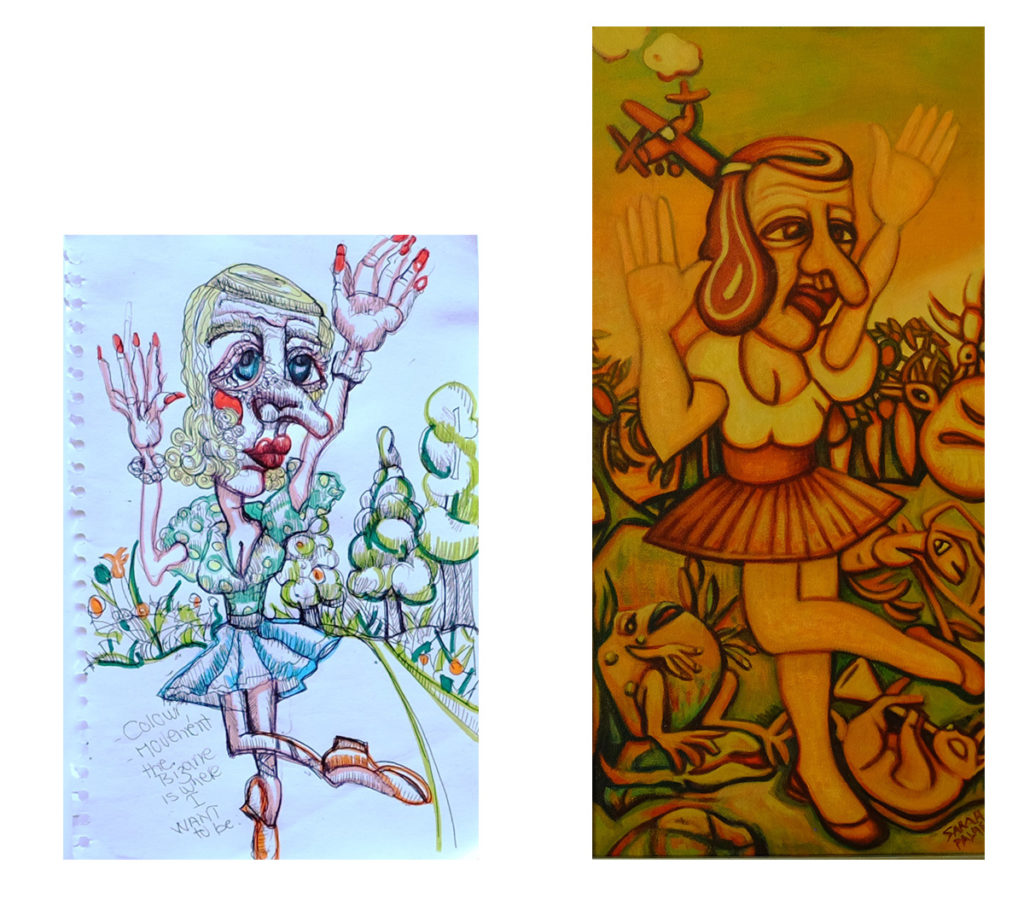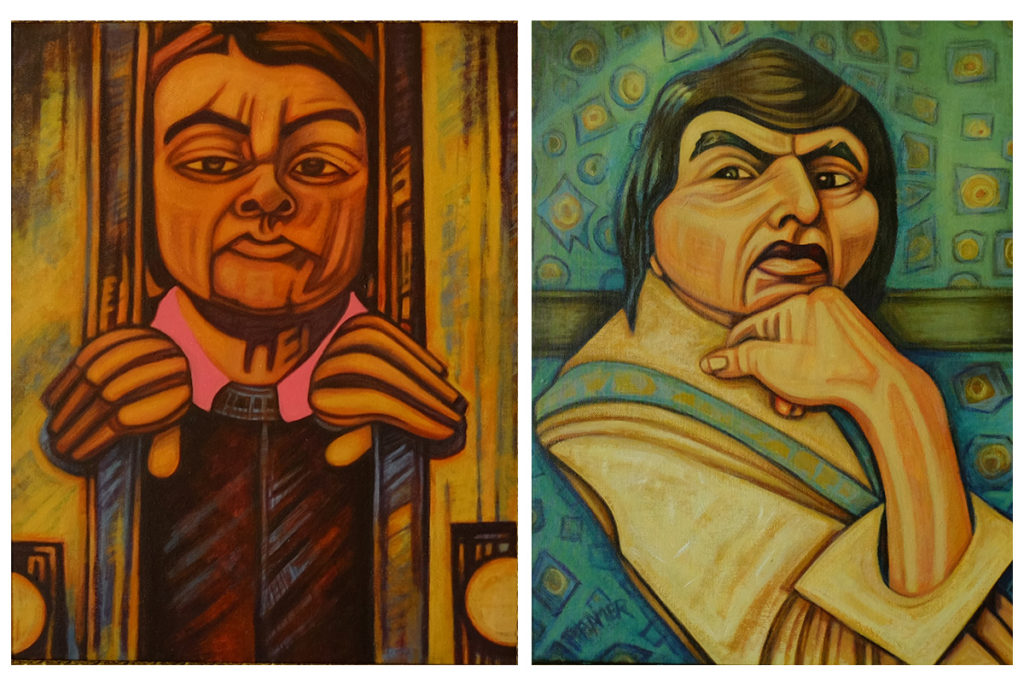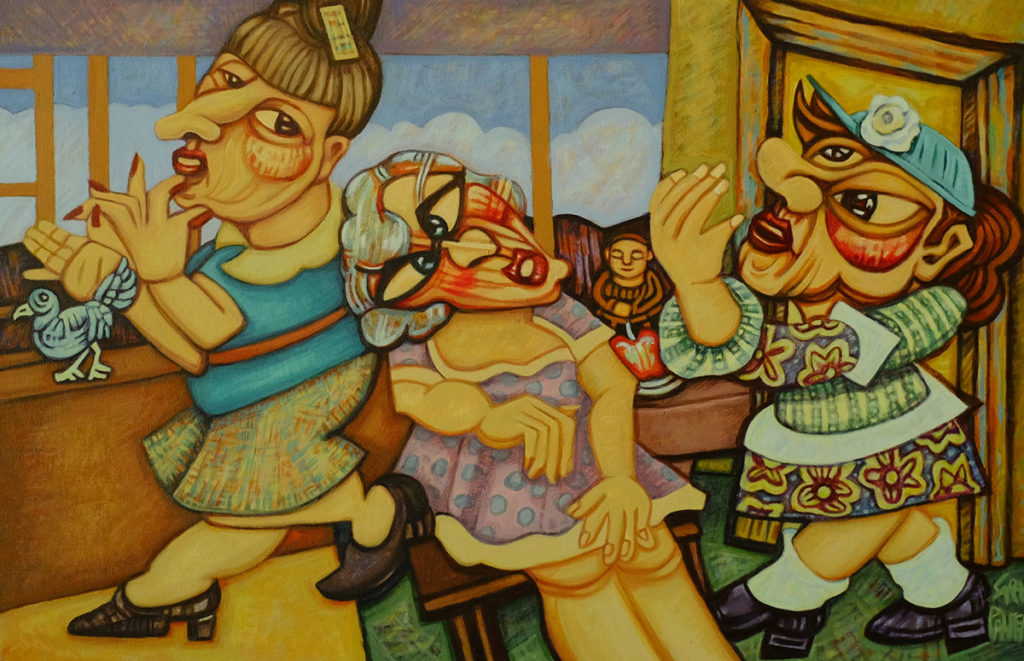Let me start by saying you don’t look like I expected. Your paintings are challenging. Some might call them edgy. Even dark. You don’t look like someone who paints those kinds of paintings.
I’m totally opposite from what you might expect if you only knew me from my paintings. You’re not the first person to say that. They expect someone bigger and louder. I don’t look very dangerous. And I’m older than people expect. They see my paintings and then they expect me to look a certain way. Don’t be sure you know someone from one aspect of their lives. We all have different facets. We all have something others don’t see or understand.

Where does the edginess of your paintings come from? Your paintings are not easy. Many have a sense of melancholy. Are you an unhappy person?
Laughs…
I don’t think I’m unhappy. I think what you see on the canvas comes from my subconscious. I see myself as a pretty conservative person that follows the rules and morals of society. The edginess in my paintings may be how I express a rebellion against the constraints of society.
It’s difficult for painters to make a living as full time artists. How have you managed to paint and eat?
I went to school to become a graphic designer and I worked in that field for a while before I realized that I wanted to paint. I wasn’t totally happy working in graphic design and couldn’t imagine working as a graphic designer and painting on the side. It wasn’t who I was. I had always worked as a volunteer in social work and I was able to get part-time work in a woman’s shelter and then once that ended I found a job in mental health which I totally enjoyed. When my clients saw my paintings they often felt that I was painting their stories. I wasn’t painting their stories but they could relate to my paintings.
I worked full time. I got up at 6 o’clock every weekday morning and got in an hour of painting. I painted much longer on the weekends and I did shows in the summer. I had a full time job and painted every day for almost thirty years.
So you started painting fairly late in life?
I painted when I was a child. I saved my money to buy paints. I would order paints by mail. I drew all the time. My parents didn’t know about art schools and I didn’t know that you could have a career in painting so when I was young I assumed that painting was more of a hobby. Now I see myself as a professional painter.
My father, who was a plastic surgeon, also loved to paint and would paint very weird people. Stranger than the people I paint. More cartoonish. He was prolific and painted on walls and on all sizes of cavasses. He loved painting as a hobby. We even had a show together one time and we both sold pieces.
When I look close up at some of your paintings I notice that you have created a lot of texture on your canvas…a sort of 3D effect. How do you do that?
I use coloured tissue paper. I take little pieces of paper and stick them on the cavass with gesso and once I have the whole cavass covered I paint over it with my acrylic paints. It can be challenging because you need more paint to make it look neat on the canvas but the process gives me a coloured palette on my canvas to start with. I don’t start with a blank slate. I often use this process to create a canvas that inspires me to try something different.
Your paintings are really well planned but they are not static. Your characters are always
moving…dancing.
My plans come from my sketch book. I draw all the time. My drawings come from my subconscious. I sit there with a pen in hand and go with the flow. I usually draw human forms. I love to extend arms and legs and feet and noses and hands. I have lots of sketches to give me ideas of what I want to paint. I develop a story line by looking at different sketches. I also keep a file of photos and stories from newspapers and magazines and use them to give me ideas.
After I have developed a plan for a painting I use tracing paper to take every line of a sketch to copy it to the canvas. When I am painting on a canvas that I have prepared with coloured tissue paper, the texture of the paper on the canvas makes my copies more wobbly and not straight. It gives me a 3D effect. I have included examples of my sketches on the Art Ignotum site and you can see how the sketches end up in my paintings. For example, the Blue Dancer sketch was the basis for the Fairy Tale With Airplane painting.

I find that many of your paintings seem to tell a dark story. However, even in those paintings you use bright colours.
When I have my drawings on the canvas I start to formulate the colours that I want to convey my thoughts and feelings on the story line. I don’t use premixed colours. I only have four different colours that I mix to get the colours that fit whatever is happening in the painting. Some of the mixes are accidental but I also look at famous paintings to get ideas for colours.
You only use four different tubes of colours?
The three primary colours and white. I make my colours from there. Once I start with a colour I have to remember the formula for the colour. For example, if a character has a certain skin colour, I need the same colour to continue with my painting the next day. So it is a bit of chemistry. I need a bit more blue, a little more red, a little more yellow, a little bit of white.
You’re really good a formulating colours. If I had to touch up the paint my wall, could you formulate a colour that matches?
Laughs…
I can pretty well do that. Are you thinking I should start a touch up business?
No. Although….
Getting back to your paintings I notice that many of your characters are wearing high heels and dresses. When I referred to some of these characters as “she” you corrected me and told me they were men. You also have some portraits of people with very strong features and when I referred to them as “he” you corrected me and told me they were women.
I remember the paintings you are talking about. You thought the person in Closed and the person in Marg were men. They are women.

The people in my paintings aren’t pretty. I like strong looking people. Characters that express a mood or story and I like the reality that no one is who we think they are. We make quick judgements. I’m hoping that by putting high heels on a man or that painting a woman with strong features makes you think about what that person may represent. Who are they? How do they define themselves? I like that they question our stereotypes. The paintings push you to look beyond stereotypes.
OK, but when we discussed your painting, Three Sisters, you told me the character on the right who wears a dress and heels is a man. But the title of the painting is Three Sisters. And he’s a man?

Yes.
Pause…
OK…I’ll have to think more about my story for the Three Sisters painting.
Let’s talk more about your story lines. I have to look at one of your paintings several times to see everything in the painting. I ask why each element is in the painting and how the elements are related to each other. I create a story that ties everything together. And then if I see the painting days or weeks later I find that I am imagining a different story. The stories for your paintings keep changing for me.
The story in a painting can change because we change.
Your story can be different from my story because of what you see in the painting. I create my own story and I don’t expect everyone to have the same story as me. Everybody has different experiences. We all look at things differently.
Thanks Sarah. I look forward to seeing more of your paintings.
Learn more about Sarah and her art on Instagram @sarahpalmerartist52.
Contact Sarah at [email protected].